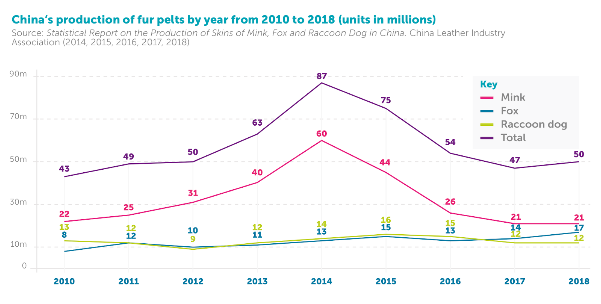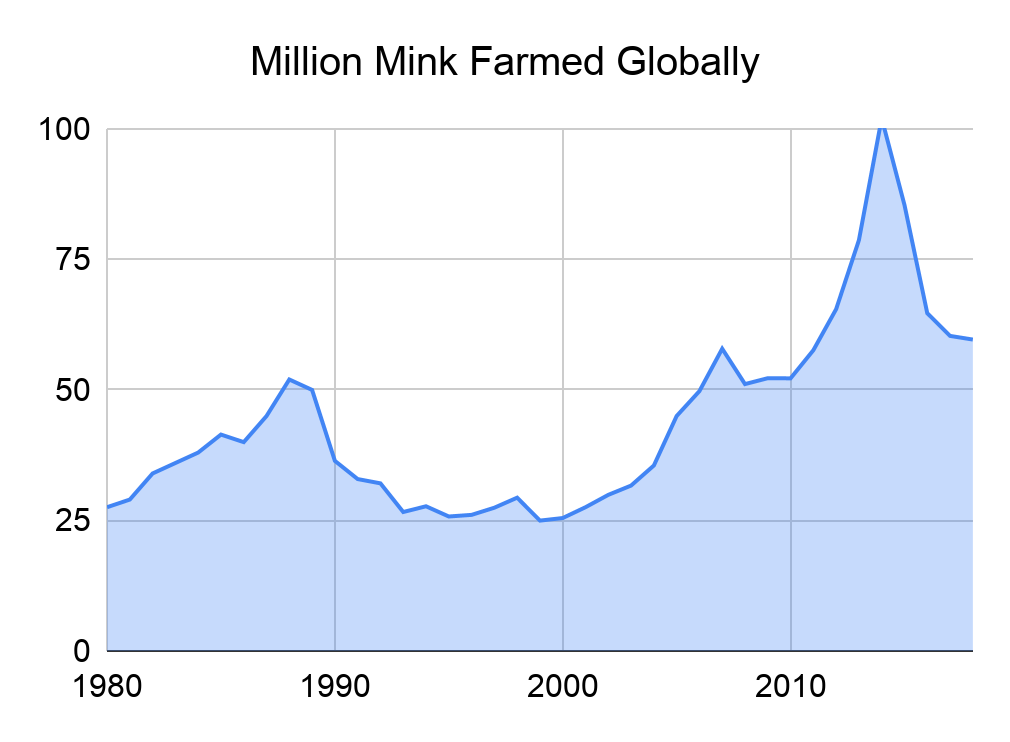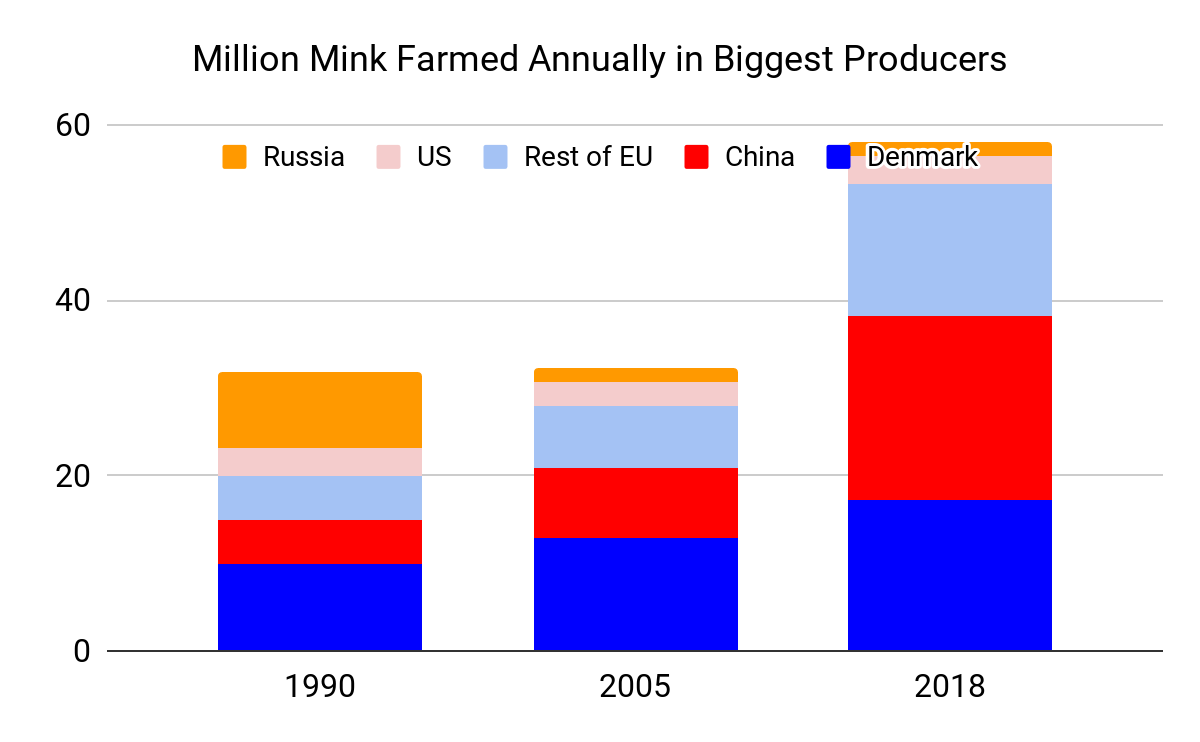This post originally appeared in the monthly farm animal welfare newsletter written by Lewis Bollard, our program officer for farm animal welfare. Sign up here to receive an email each month with Lewis’ research and insights into farm animal advocacy. Note that the newsletter is not thoroughly vetted by other staff and does not necessarily represent consensus views of Open Philanthropy as a whole.
It seems like a good time to be a fur-bearing animal. In 2016, Giorgio Armani succumbed to years of protest and took his iconic brand fur-free. Gucci, Versace, Prada, Michael Kors, Burberry, and a half dozen other major labels followed suit.
So did politicians. Since 2017, Belgium, Croatia, the Czech Republic, Ireland, Luxembourg, Norway, and Serbia have either passed or implemented fur farming bans. This year, Los Angeles and San Francisco passed fur sales bans, as did the California Assembly (the ban is now in the state senate), while New York state and city lawmakers proposed bans.
Fur production and sales may also finally be in decline. Global statistics are unreliable, but fur sales appear to have peaked in 2014. And in fur’s largest producer, China, ActAsia estimates that fur production fell from a 2014 high of 87M minks, foxes, and raccoon dogs slaughtered, down to 50M last year (see graph below).

This is welcome news. We focus on other farmed animals because of the tough triage of factory farming: while about 45M animals are suffering on fur farms at any time, 5.3B mammals, 19.1B birds, and 57.5B fish are suffering on meat, egg, and fish farms. But fur animals may have it the worst, as wild animals typically confined to solitary cages, with some even skinned alive. And fur seems uniquely indefensible: 20-50 minks are farmed, collectively for 10 – 33 years, to produce just one fur coat, which retails for more than the global median per-capita annual income.
So do these wins suggest that anti-fur activists will soon end the archaic fur industry? Have their hard-hitting tactics — from storming catwalks to tossing a dead raccoon onto Anna Wintour’s plate — worked? And could their success provide a model for other animal issues?
The anti-fur rollercoaster
“Fur Industry Shrinking With No End in Sight,” the New York Times headline proclaimed, in 1991. Since then, the number of mink — the animal most commonly farmed for their fur — slaughtered each year has more than tripled, to more than 100M mink in 2015.
(Rabbits and ducks are farmed in far greater numbers than mink, 970M and 3B respectively each year, but mostly for their meat. Some portion of these rabbits, though, are farmed exclusively for their fur, while a highly disputed portion of down comes from live plucked ducks and geese. Perhaps another 12M raccoon dogs and 20M foxes are farmed for fur annually, while about 5M wild animals are trapped for their fur.)

Why? A common activist explanation is that we moved on from fur too soon. In the 1980s and 90s, the largest animal rights groups prioritized fur campaigns. But as activists like Henry Spira directed the movement toward the much larger number of animals raised for meat, the fur campaigns receded. Under this story, fur is a lesson in the importance of sticking with the fight.
Meanwhile, the industry credits its forceful pushback against anti-fur forces. The fur industry funded young designers to use fur, boosting its presence in London, Milan, New York, and Paris fashion weeks, where 73% of designers included fur in their fall 2015 collections. It pushed fur trim, as in Canada Goose jackets, and capitalized on the naturalistic fallacy to frame fur as a greener option than artificial faux fur.
But the data doesn’t fully support either story. Mink farming numbers rose rapidly through the 1980s, even as protests mounted, and fell mostly over just a few years, 1989-93, not associated with any special uptick in fur protests. They then rose rapidly through the 2000s, even as fur protests intensified.
Economic trends offer a more plausible explanation. Fur’s fall in 1989-93 coincided with both the fall of the Soviet Union, fur’s biggest producer, and a global financial crisis, which hurt demand. Fur’s resurgence since 2000 coincided with China’s admission to the World Trade Organization, which allowed China to quickly become the world’s largest exporter of fur, and fueled the prosperity that helped it later become the world’s biggest consumer of fur too. Fur’s recent decline coincided with an economic downturn in Russia and Chinese President Xi Jinping’s anti-corruption campaign, which have hurt demand in fur’s two biggest markets.
But activist wins are likely playing an increasing role in suppressing demand. The fur industry seems especially concerned about the defection of top designers like Donatella Versace, who set the trends for the global fashion industry. Recent retail wins, like online retailer giant Yoox Net-a-Porter, affect even China, where Yoox has a partnership with Alibaba. Chinese industry reports described “a deep sense of gloom” at this year’s Beijing fur trade show.

Lessons learned
So what can farm animal advocates learn from the successes and failures of fur activism to date?
- Focus on corporates, not individuals. Three decades of anti-fur activism have barely budged US public opinion, which still mostly views fur as morally acceptable. But a decade of more targeted campaigns, coordinated by the Fur-Free Alliance, has secured pledges from 1,017 retailers and designers to go fur-free. As with caged eggs, advocates do best when they focus on the few hundred retailers that sell most animal products, not the few billion consumers who buy them.
- Ban sales, not production. European fur production bans have done little to suppress supply (see graph above) or demand. But after the EU banned the sale of seal fur in 2009, the number of Canadian seals killed annually fell threefold, to fewer than 100K. Since the WTO upheld that sales ban, the EU could likely legally ban the sale of other cruelly produced goods. Advocates should push it do so, starting with eggs, meats, and furs that don’t meet the EU’s existing animal welfare standards.
- Present good alternatives. Giorgio Armani, Anna Sui, and Michael Kors all cited innovation in faux fur as a reason to drop fur, just as Dunkin’ cited plant-based meat innovation in adding Beyond Meat’s sausage to its menu. Alternatives seem like an especially promising approach in China, which accounts for about 57% of global fur sales and 40% of all farm animals confined globally. A new group, the Material Innovation Initiative, wants to promote technological alternatives to fur and other animal-based fabrics, as GFI and PBFA are doing for alternatives to meat, eggs, dairy, and fish.
Thanks for reading. Our new farm animal welfare researcher, Persis Eskander, contributed research for this newsletter. I’m looking forward to sharing more of her insights with you in future newsletters.
